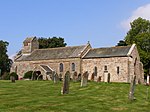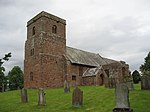Bolton, Cumbria
Bolton, CumbriaCivil parishes in CumbriaCumbria geography stubsEden DistrictUse British English from September 2019 ... and 1 more
Villages in Cumbria

Bolton is a village and civil parish in the Eden District of Cumbria, England, about 4 miles (6 km) north west of Appleby-in-Westmorland, and on the River Eden. According to the census of 2001, it had a population of 416, increasing to 435 at the census of 2011. The parish touches Brougham, Colby, Cliburn, Crackenthorpe, King's Meaburn, Kirkby Thore, Morland and Temple Sowerby.
Excerpt from the Wikipedia article Bolton, Cumbria (License: CC BY-SA 3.0, Authors, Images).Bolton, Cumbria
Geographical coordinates (GPS) Address Nearby Places Show on map
Geographical coordinates (GPS)
| Latitude | Longitude |
|---|---|
| N 54.604 ° | E -2.561 ° |
Address
CA16 6AL
England, United Kingdom
Open on Google Maps








